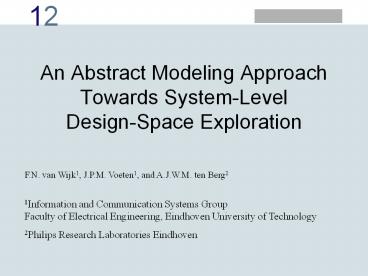An Abstract Modeling Approach Towards System-Level Design-Space Exploration PowerPoint PPT Presentation
1 / 35
Title: An Abstract Modeling Approach Towards System-Level Design-Space Exploration
1
An Abstract Modeling Approach Towards
System-LevelDesign-Space Exploration
F.N. van Wijk1, J.P.M. Voeten1, and A.J.W.M. ten
Berg2 1Information and Communication Systems
GroupFaculty of Electrical Engineering,
Eindhoven University of Technology 2Philips
Research Laboratories Eindhoven
2
Contents
- Motivation
- Modeling concepts
- Simulation
- Performance analysis
- Design-space exploration exercise
- Conclusion and future work
3
Motivation
- Traditional hardware/software co-design methods
suffer from too many iterations that consume too
much costly development time.
4
Abstraction pyramid
Source P. Lieverse et al. A Methodology for
Architecture Exploration of Heterogeneous Signal
Processing Systems, Journal of VLSI Signal
Processing, vol. 29, no. 3, 2001.
5
Abstraction pyramid
6
Motivation
- Traditional hardware/software co-design methods
suffer from too many iterations that consume too
much costly development time. - ÞNeed for specification and design methods that
support fast exploration of design alternatives
at an early stage of the design trajectory at a
system-level of abstraction
Embedded systems have heterogenous
architecture. ÞUse Y-chart
7
The Y-chart
Application(s)
Architecture
Source A.C.J. Kienhuis. Design Space Exploration
of Stream-based Dataflow Architectures Methods
and Tools, Ph.D. thesis, Delft University of
Technology, 1999.
8
Motivation
- Traditional hardware/software co-design methods
suffer from too many iterations that consume too
much costly development time. - ÞNeed for specification and design methods that
support fast exploration of design alternatives
at an early stage of the design trajectory at a
system-level of abstraction - Embedded systems have heterogenous architecture.
- ÞUse Y-chart
ÞUse abstract executable models Taking
well-founded design decisions requires a
well-defined modeling language ÞUse POOSL
9
POOSL
- The Parallel Object-Oriented Specification
Language POOSL is a formal specification language
based on a probabilistic timed version of process
algebra CCS and on the basic concepts of
traditional object-oriented programming languages
(Smalltalk, Java, C). - Why use POOSL?
- formal semantics
- expressiveness
- abstraction
- compositional
- behavioral and structural
- real-time
- probabilistic
- transparency
10
Example POOSL model
11
Validation
12
Contents
- Motivation
- Modeling concepts
- Simulation
- Performance analysis
- Design-space exploration exercise
- Conclusion and future work
13
Model structure
System Model
Functional Model
T3
T1
T2
Mapping
Resource Model
R1
R2
R3
R4
Performance Analysis
14
Resource Model
- Three basic, parameterizable resource types
- Processing Resource (P)
- Communication Resource (C)
- Storage Resource (S)
15
Resource Model
- Three basic, parameterizable resource types
- Processing Resource (P)
- Operate()()
- instruction String instructionDelay Real
- task?resourceRequest(instruction)
- instructionDelay instructionTable
getDelay(instruction) - delay(instructionDelay)
- task!acknowledge
- Operate()().
- Communication Resource (C)
- Storage Resource (S)
16
Resource Model
- Three basic, parameterizable resource types
- Processing Resource (P)
- Communication Resource (C)
- Operate()()
- packetSize, duration Real
- fifo?requestBW(packetSize)
- delay(transferDelay packetSize)
- fifo!ready
- Operate()().
- Storage Resource (S)
17
Resource Model
- Storage Resource (S)
- Operate()()
- packetSize Real
- sel
- room gt 0fifo?malloc(packetSize)
- if room gt packetSize then room room -
packetSize - else packetSize room room 0 fi
- fifo!grant(packetSize, room)
- or
- fifo?free(packetSize)
- room room packetSize
- fifo!ready(room)
- les
- Operate()().
18
An example communication channel
19
Contents
- Motivation
- Modeling concepts
- Simulation
- Performance analysis
- Design-space exploration exercise
- Conclusion and future work
20
Structure diagram
Functional Model
M a p p i n g
Resource Model
21
Message flow diagram
22
Message flow diagram
23
Contents
- Motivation
- Modeling concepts
- Simulation
- Performance analysis
- Design-space exploration exercise
- Conclusion and future work
24
Model Analysis
- Each model is equipped with a mathematically
defined semantics. - Each model uniquely defines a timed probabilistic
labelled transition system. - This LTS is the basis for all analyses
- Formal verification (exhaustive)
- Simulation-based verification (non-exhaustive)
- Analytical performance evaluation (exhaustive)
- Simulation-based performance evaluation
(non-exhaustive).
25
Performance Analysis
- Specify the performance metric as a (temporal)
reward. - Examples utilizations, jitter, buffer fill
levels, throughput. - Determine the long-run average metric value
- Analytically
- Generate the complete timed probabilistic
labelled transition system - Interpret it as a Markov chain with (temporal)
reward structure - Compute performance metric by means of
equilibrium analysis - Certain/precise results but only applicable in
case of relatively small finite-state systems. - By simulation
- Generate one execution trace
- Estimate the metric value, confidences and errors
by means of the central limit theorem for Markov
chains - Uncertain results but applicable in case of large
and even infinite-state systems.
26
Contents
- Motivation
- Modeling concepts
- Simulation
- Performance analysis
- Design-space exploration exercise
- Conclusion and future work
27
Example Producer-Filter-Consumer (PFC)
alternative 1
28
Example Producer-Filter-Consumer (PFC)
alternative 2
29
PFC-example (contd)
30
PFC-example (contd)
31
PFC-example Performance Analysis
32
Contents
- Motivation
- Modeling concepts
- Simulation
- Performance analysis
- Design-space exploration exercise
- Conclusion and future work
33
Conclusions
- An abstract modeling approach to system-level
design-space exploration for complex
heterogeneous systems has been presented. - The approach supports fast exploration of
alternative realizations using abstract
executable formal models. - Functional models are mapped onto Resource models
(strict coupling, mutually disconnected
resources) and together form a System Model. - Strict coupling enables the modeling of
non-determinism. - Both control and data oriented behavior can be
expressed. - Modeling of resource sharing is straightforward.
- Simulation-based performance analysis yields
performance figures. Based on the formal
semantics of POOSL, their accuracy can be
estimated.
34
Future Work
- Add support for stream-based functional models.
- Assess performance metrics, their representation
and accuracy analysis further. - Extension of schedulers / arbiters to support
multiple resource scheduling policies. - Þ Validation of the approach against a relevant
industrial case is ongoing.
35
Thank you.Questions?
- Eindhoven University of Technology
- Information and Communication Systems Group
- http//www.ics.ele.tue.nl
- f.n.v.wijk_at_tue.nl

